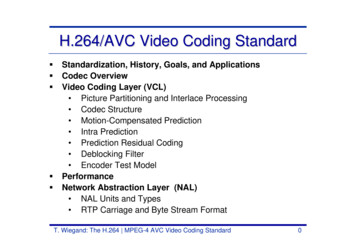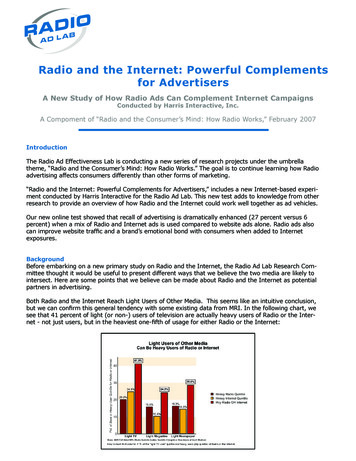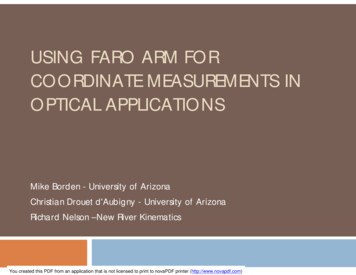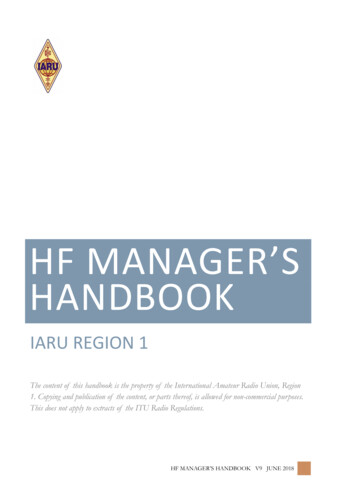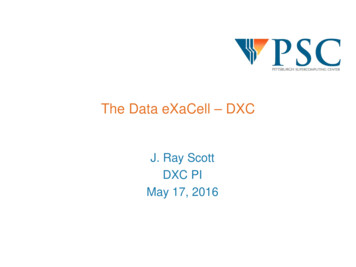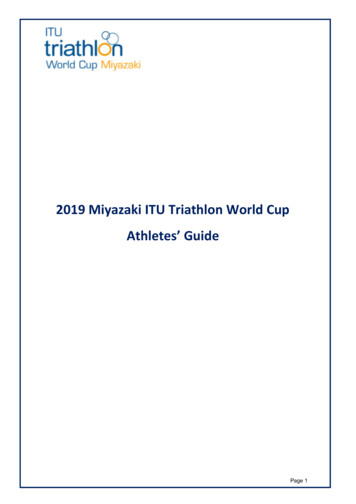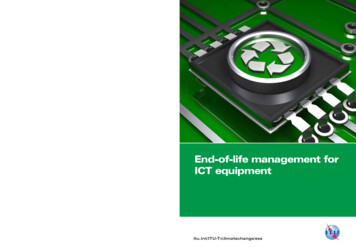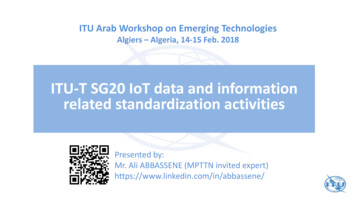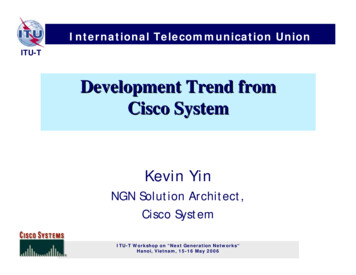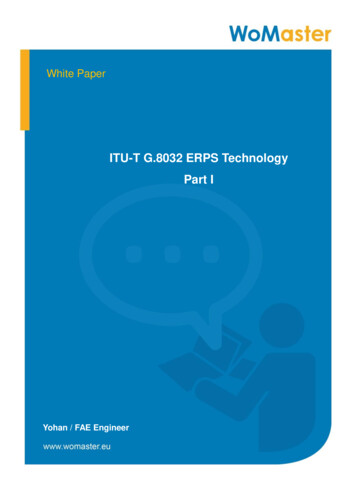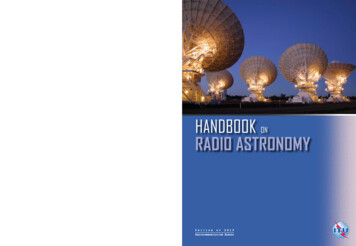
Transcription
Edition of 2013International Telecommunication UnionSales and Marketing DivisionPlace des NationsCH-1211 Geneva 20SwitzerlandFax: 41 22 730 5194Tel.: 41 22 730 6141E-mail: sales@itu.intWeb: www.itu.int/publications*38650*Printed in SwitzerlandGeneva, 2013ISBN: 978-92-61-14481-4Photo credit: ATCA David SmythHANDBOOK ON RADIO ASTRONOMYHANDBOOK ONRADIO ASTRONOMYE d i t i o no f2 0 1 3Radiocommunication Bureau
Handbook onRadio AstronomyThird EditionEDITION OF 2013RADIOCOMMUNICATION BUREAU
Cover photo: Six identical 22-m antennas make up CSIRO's Australia Telescope Compact Array, an earth-rotationsynthesis telescope located at the Paul Wild Observatory.Credit: David Smyth. ITU 2013All rights reserved. No part of this publication may be reproduced, by any means whatsoever, without the prior writtenpermission of ITU.
- iii -Introduction to the third edition bythe Chairman of ITU-R Working Party 7D(Radio Astronomy)It is an honour and privilege to present the third edition of the Handbook – Radio Astronomy, and I do sowith great pleasure.The Handbook is not intended as a source book on radio astronomy, but is concerned principally with thoseaspects of radio astronomy that are relevant to frequency coordination, that is, the management of radiospectrum usage in order to minimize interference between radiocommunication services. Radio astronomydoes not involve the transmission of radiowaves in the frequency bands allocated for its operation, andcannot cause harmful interference to other services. On the other hand, the received cosmic signals areusually extremely weak, and transmissions of other services can interfere with such signals.In twelve chapters and five Appendices, the Handbook introduces the reader to radio astronomy viewed as aradiocommunication service for the purpose of frequency coordination. It starts with a preamble on radioastronomy and society, outlining the role and benefits of radio astronomy to society, often extending beyondastronomy. The Handbook then covers areas such as the characteristics of radio astronomy, preferredfrequency bands for observations, special radio astronomy applications, vulnerability to radio frequencyinterference (RFI) from other services, and issues associated with sharing the radio spectrum with otherservices. Additional chapters have been included in this third edition of the Handbook on techniques formitigating the effects of RFI, on the establishment and characteristics of Radio Quiet Zones (RQZ), on thesearches for extraterrestrial intelligence (SETI) and on ground-based radar astronomy. New Appendices havebeen added to explain the use of units and the dB scale in radio astronomy, and an extensive list ofacronyms.Almost ten years have passed since the second edition of the Handbook – Radio Astronomy was published.In the meantime ITU has held three World Radiocommunication Conferences (WRC-2003, WRC-2007 andWRC-2012).In this period, there has been a virtual explosion in the development of communication services, and wirelessservices are now all pervasive in our multi-connected society. In parallel, technological developments inradio astronomy have enabled observations over very wide frequency bands, often not covered by the ITUallocations. Such developments present a challenge for the protection of radio astronomy and new methodshad to be explored. New techniques on RFI mitigation are under continuous development, and RQZ havebeen defined to provide unique places on the planet where radio astronomy can proceed with minimalinterference. Such developments have been covered within ITU with new and extensive ITU-R Reports.Radio astronomy is now also operating in bands above 275 GHz, with the ALMA observatory in SouthAmerica, which commenced operations in 2013. These bands are not covered by the formal ITU allocations,but WRC-2012 clarified the usage of such bands by the passive services without precluding the developmentof active services. Studies have shown that sharing between services would be relatively easy at such highfrequencies.Just before WRC-2012, ITU-R Working Party 7D (WP 7D) started to revise the Handbook, and this workcontinued over two years. WP 7D is the section within ITU-R Study Group 7 (Science services) that isresponsible for radio astronomy, SETI, and radar astronomy. In parallel with the necessary revision andexpansion of the Handbook, WP 7D had to revise relevant ITU-R Recommendations and Reports to protectthe radio astronomy service. The third edition of the Handbook successfully incorporates the results of theseefforts by the Working Party members.Radio AstronomyIntroduction
- iv -I wish to acknowledge the considerable effort of a small group of people without whose involvement theHandbook could not have materialized. I am particularly indebted to the following WP 7D members (inalphabetical order):–Dr. W. Baan (Netherlands), Dr. S. H. Chung (Korea), Dr. A. Clegg (United States of America),–Dr. M. Davis (United States of America), Dr. T. Gergely (United States of America), Dr. A. Jessner(Germany),–Dr. G. Langston (United States of America), Dr. B. Lewis (United States of America), Dr. H. Liszt(United States of America),–Dr. M. Ohishi (Japan), Dr. P. Thomasson (United Kingdom), Dr. W. van Driel (France).Other contributors were: Dr. J. Romney from USA, who extensively re-wrote the sections on very longbaseline interferometry (VLBI), Dr. J. Lovell from Australia for the section on geodetic VLBI, and Dr. K.Tapping (Canada) for revising the section on solar astronomy. The ITU-R Secretariat provided considerablehelp and in particular the Study Group 7 Counsellor Mr. Vadim Nozdrin and the Secretariat led byMrs. Elizabeth Mostyn-Jones. Finally I would like to express my sincere appreciation to the Chairman ofStudy Group 7, Dr. Vincent Meens and the vice-Chair responsible for the Handbooks Dr. John Zuzek, fortheir continuing encouragement and support during this work.I thank all contributors and wish the ITU-R Handbook – Radio Astronomy every success.Anastasios TzioumisChairman, ITU-R Working Party 7DIntroductionRadio Astronomy
-v-PREFACEThe Handbook on Radio Astronomy has been developed by experts of Working Party 7D of ITU-R StudyGroup 7 (Science services), under the chairmanship of Dr. A. Tzioumis (Australia), Chairman, WorkingParty 7D.Radio astronomy plays a key role in the study of problems in fundamental physics and cosmology. Many ofthe phenomena studied cannot be studied in other parts of the electromagnetic spectrum. To cite but a fewexamples: the emission line of neutral atomic hydrogen; cosmic microwave background radiation and itsangular structure, which is of immense significance in cosmology; the huge regions of synchrotron radiationassociated with radio galaxies; and regions of star formation that are hidden by dust in optical frequencies.Using radio frequencies, it is possible to achieve the highest angular resolution and the most precisemeasurement of angular positions and of spectral lines and their Doppler shifts. For this reason, radioastronomy, far from being a mere adjunct to traditional optical methods, plays a leading role in researchcarried out in many areas of astronomy and astrophysics.Apart from this, radio astronomy, like any fundamental science, stimulates development in other branches. Itis to radio astronomy that we owe the development of low-noise receivers and antennas that enable us to usea single antenna to capture signals of differing polarisations. Methods developed in radio astronomy tocombat radio echo are now being used successfully in WiFi-type mobile communication systems. Thefoundations of radionavigation theory that are used today in a range of systems were developed andconfirmed in radio astronomy. The need to process huge quantities of data in radio astronomy has resulted inmajor improvements in automated data processing, including the development of methods for parallel dataprocessing and new programming languages. In the medical sphere, radio astronomy has led to theintroduction of X-ray diagnostics and computerized tomography.All the above indicate the importance of the international recognition and protection of spectrum used byradioastronomy. This Handbook gives the reader a very useful source of information relevant to themanagement of radio spectrum usage in order to minimize the interference caused to this valuable service.François RancyDirectorRadiocommunication BureauRadio AstronomyPreface
- vii -TABLE OF CONTENTSPageIntroduction to the third edition by the Chairman of ITU-R Working Party 7D (Radio Astronomy) .iiiPREFACE.vPREAMBLERadio Astronomy and Society .10.1Introduction to astronomy .10.2The role of radio astronomy .10.3Economic and societal value .40.3.1 Introduction .40.3.2 Economic and societal value of radio astronomy research .4Solar Radio Monitoring .80.4.1 Introduction .80.4.2 Overview of solar radio monitoring.90.4.3 Impact and societal value.9Solar-driven effects on satellites .10Ionospheric effects .10Geomagnetic effects on ground systems .100.5Trends in radio astronomy .110.6Conclusions .120.4CHAPTER 1Introduction.131.1The Radiocommunication Sector and World Radiocommunication Conferences .131.2The Radio Regulations and frequency allocations .141.3Radio astronomy as a radiocommunication service .141.4Frequency allocation problems for radio astronomy .16CHAPTER 2Characteristics of the Radio Astronomy Service .182.1The RAS .182.2Origin and nature of cosmic radio emissions .182.3Continuum radiation .192.3.1 Time variability of continuum radiation .202.3.2 Measurement of continuum radiation .24Spectral-line radiation .272.4.1 Types of spectral lines .272.4.2 Measurement of spectral lines .282.5Modern Practice .302.6Conclusion .302.4CHAPTER 33.1Preferred frequency bands for radio astronomy observations .32General considerations .323.1.1 Ground-based radio astronomy observations .32Radio AstronomyTable of Contents
- viii -Page3.23.33.1.2 Space-based radio astronomy observations .33Preferred continuum bands .343.2.1 Observations at low frequencies .353.2.2 High frequency bands for continuum observations .36Bands for spectral-line observations .36CHAPTER 4Vulnerability of radio astronomy observations to interference .404.1Introduction .404.2Basic considerations in the calculation of interference levels.404.2.1 Detrimental-level criterion for interference .404.2.2 Antenna response pattern.414.2.3 Averaging time (integration time) .424.2.4 Percentage of time lost to interference .42Sensitivity of radio astronomy systems and threshold values of detrimental interference .434.3.1 Theoretical considerations .434.3.2 Estimates of sensitivity and detrimental interference levels .444.4Response of interferometers and arrays to radio interference .464.5Pulsars.514.6Achieved sensitivities .514.7Discussion of interference.524.7.1 Interference levels .524.7.2 Interference from astronomical sources .524.7.3 Special considerations for transmitters on geostationary satellites.524.7.4 Filtering .544.7.5 Interference levels capable of damaging or saturating a radioastronomy receiver .54Monte Carlo analysis .54Annex 1 to Chapter 4 .56CHAPTER 5Sharing the radio astronomy bands with other services .58General remarks .585.1.1 Protection criteria for the RAS .58Separation distances required for sharing with a single transmitter (see RecommendationITU-R RA.1031) .605.3Sharing within LoS .615.4Sharing with services with terrestrial transmitters .625.5Sharing with mobile services .625.6Sharing in radio astronomy bands below 40 GHz .635.6.1 The band 1 330-1 427 MHz .655.6.2 The band 4 800-5 000 MHz .655.6.3 The bands 22.01-22.21 and 22.21-22.5 GHz .65Sharing in radio astronomy bands above 40 GHz .665.7.1 Sharing between 60 and 275 GHz .664.34.85.15.25.7Table of ContentsRadio Astronomy
- ix -Page5.7.2 Sharing above 275 GHz .665.8Sharing with deep-space research .705.9Time sharing .705.9.1 Time and frequency sharing coordination .70CHAPTER 66.16.26.36.46.56.6Interference to Radio Astronomy from transmitters in other bands .72Introduction .726.1.1 Definitions from the RR .726.1.2 Additional definitions .726.1.3 Mechanisms of interference from transmitters in other bands.73Limits for unwanted emissions from active services .746.2.1 Limits within the spurious emissions domain.746.2.2 Limits within the OoB emissions domain.756.2.3 Limits on unwanted emissions of active services to protect radio astronomy bands .75Performance of radio astronomy receivers .766.3.1 Filtering of band-edge interference .766.3.2 Non-linear effects and intermodulation .786.3.3 Linearity.796.3.4 Filtering and digitization.79Interference from transmitters of services in other bands .806.4.1 Services which could cause interference to radio astronomy through adjacent-bandand harmonic mechanisms .806.4.2 The transition to digital television and its impact on the unprotected use by theradio astronomy service of bands used for terrestrial television broadcasting .806.4.3 Interference from satellite transmissions .84Unwanted emissions from wideband modulation .896.5.1 Usage of broadband modulation .896.5.2 Pulse shaping to reduce unwanted emissions .906.5.3 Example of interference from broadband modulation. .906.5.4 Example: Radio interference from the IRIDIUM (HIBLEO-2) MSS system .91Conclusions .93References.94Special techniques, applications and observing locations .957.1Introduction .957.2VLBI, including Space VLBI .967.2.1 Space VLBI .967.2.2 Geodetic applications using VLBI.997.3Radio astronomy from the L2 Sun-Earth Lagrangian point .997.4Radio astronomy from the shielded zone of the Moon . 101CHAPTER 77.4.1 The shielded zone of the Moon . 1017.4.2 Spectral ranges preferred for observations from the Moon . 1017.4.3 Regulation of use of the shielded zone of the Moon . 102Radio AstronomyTable of Contents
-x-Page7.5Terrestrial sites with low atmospheric absorption . 1037.5.1 Antarctica. 1037.5.2 Cerro Chajnantor, Chile . 1037.5.3 Mauna Kea, Hawaii . 1037.5.4 Mt. Graham, Arizona . 1037.6Pulsar observations and application as time standards . 1047.6.1 Pulsars as standard clocks . 1047.6.2 Pulsars as reference coordinate objects . 1047.7Solar monitoring . 104CHAPTER 8Interference mitigation . 1078.1Introduction - Objectives . 1078.2Signatures of RFI sources and their impact . 1078.3RFI Mitigation Methodologies - layers of mitigation . 1088.4Pro-active methods - changing the RFI environment . 1088.5Pre-detection & post-detection. 1098.6Pre-correlation. 1098.6.1 Antenna-based digital processing . 1098.6.2 Adaptive (temporal) noise cancellation . 1108.6.3 Spatial filtering and null steering . 1108.7At correlation . 1118.8Post-correlation - before or during imaging . 1118.9Implementation at telescopes - strategy . 1118.10 Conclusions . 112CHAPTER 99.1Radio quiet zones . 114Introduction . 1149.1.1 Definition and general requirements of a radio quiet zone . 1149.1.2 Role of regulation . 1149.2Considerations in developing an RQZ . 1159.2.1 Geographic. 1159.2.2 Frequency . 1159.2.3 Impact of RFI on RAS observations . 1159.3Electromagnetic environment . 1159.3.1 Intentional radiators . 1159.3.2 Unintentional radiators . 1169.3.3 Propagation of interfering signals . 1179.4Methods to achieve an RQZ. 1179.4.1 Receive-side methods . 1179.4.2 Transmit-side methods – Managing an RQZ . 1179.5Implications in establishing an RQZ . 1199.5.1 Maintenance of RQZs . 1199.5.2 Long–term considerations . 120Table of ContentsRadio Astronomy
- xi -PageCHAPTER 10 Searches for extraterrestrial intelligence (Seti) using observations at radio frequencies . 12110.1 Introduction . 12110.2 Detectability of SETI signals . 12210.3 Signal intensity. 12210.4 Receiving system sensitivity . 12310.4.1 Minimum detectable signal power. 12410.5 Antenna pointing direction. 12610.6 Signal identification and interference rejection . 12710.7 Candidate bands to be searched . 127CHAPTER 11 Ground-based radar astronomy . 12911.1 Introduction . 12911.2 Sensitivity issues . 13211.3 Operational modes and bandwidth requirements . 13211.4 Radar astronomy installations . 133APPENDIX 1 Table of frequency bands allocated to radi
The Handbook is not intended as a source book on radio astronomy, but is concerned principally with those aspects of radio astronomy that are relevant to frequency coordination, that is, the management of radio spectrum usage in order to minimize interference between radiocommunication services. Radio astronomy
